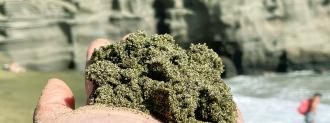Project Vesta wants to make sandy beaches greener — literally.
By spreading a unique green sand all over a Caribbean beach, the San Francisco nonprofit hopes to pull tons of carbon dioxide out of the atmosphere and lock it away for eons.
They just secured a beach in the northern Caribbean as a testbed for the wild idea.
Transforming the Beach
We all know that carbon dioxide is released into the atmosphere by burning fossil fuels, and it can be removed by growing trees and other plants. But the Earth also has other natural processes (called “carbon sinks”) that remove carbon from the air.
The natural weathering process is an important carbon sink because a chemical reaction occurs that removes CO2 from the atmosphere.
Carbon dioxide from the air collects in rainwater, in the form of carbonic acid. When it rains, the carbonic acid dissolves minerals that are commonly found in rocks on the Earth’s surface. This produces calcium ions, bicarbonate, and other compounds that rinse into rivers, lakes, and the ocean.
There, those compounds are digested by marine organisms and incorporated into their shells and bones as calcium carbonate. Once the marine animals die and settle on the seafloor, the carbon is sequestered for billions of years. What’s more, the carbonates that form raise the alkalinity of the oceans, allowing even more CO2 to be absorbed directly by the sea from the atmosphere.
But while CO2 is being pumped into the air at a record pace, this offsetting process can take millions of years – and planet Earth isn’t feeling very patient these days. So, researchers want to speed up this natural phenomenon by applying massive amounts of finely ground, carbon-dissolving minerals across beaches or agricultural land.
Project Vesta plans to leverage the ability of minerals, such as the green igneous rock olivine, to absorb greenhouse gases as it dissolves. Later this year, they’ll apply a one-centimeter layer of olivine sand to the Caribbean beach, creating the first real-world test of enhanced mineral weathering to combat climate change.
Looks Can Be Deceiving
Green beaches may sound like they belong on the planet Krypton, but olivine beaches naturally exist on earth. There are two green sand beaches in the U.S., including Papakōlea, a popular tourist destination in Hawaii. But Project Vesta’s green sand beach will be the first human-made one of its kind.
The idea of using weathering for carbon sequestration isn’t new. Last year David Beerling, a botanist at The University of Sheffield, published a study explaining the potential of enhanced rock weathering on croplands.
He says the benefits of enhanced weathering for both improving soil health and sequestering carbon could present a unique opportunity for farmers. But Beerling also raises concerns about how enhanced mineral weathering could impact the environment in coastal locations.
Unlike agricultural land, where he can establish defined boundaries, coastal zones, with daily tidal fluctuations, are more challenging to study. He says that Project Vesta could face challenges with getting buy-in from the public. They would have to demonstrate that adding enormous amounts of olivine to beaches won’t negatively impact the ocean ecosystem.
“The public regards the oceans as sacrosanct. They are already filling up with plastics and microplastics. I just can’t see how we’re going to get past ‘let’s dump a billion tons of rock into the oceans’ to capture carbon,” says Beerling.
Stephen Romaniello is on it.
As a geochemist and Project Vesta’s director of research, Romaniello says that part of his role is “thinking about where the science connects with people … thinking about how people might like the idea of putting olivine sand on a beach where they walk their dog or where they go jogging every day.”
It will become routine to manage the Earth system in a way that’s beneficial for all the organisms on Earth, including humans.
Stephen Romaniello
Romaniello says that, side-by-side, “normal” beach sand and the sand-olivine mix (which is only 10% olivine) look identical. He even mailed me a sample of this sand – I can verify that it looks like typical Caribbean white sand. It passed a crude comparison test against my geeky sand collection.
But looks can be deceiving, and Romaniello and his team will have to demonstrate that the sand is ecologically safe. To demonstrate that, the nonprofit has received permits to spread the sand on an undisclosed beach located in the Caribbean, where they will begin their baseline research later this year.
Romaniello adds that, if the sand works as expected, the biggest challenge will be achieving economies of scale. Presently, they are buying about 60 tons of olivine for small-scale experiments. But for their product to be competitive in the carbon offset market, Romaniello figures they need to buy 50,000 tons at a time.
You might be thinking about the carbon costs of shipping that much sand – and so is Vesta. But the good news is that, in terms of the carbon footprint, Romaniello says the carbon debt from shipping that olivine will only equal about 5% of the total carbon dioxide it could sequester.
Is Enhanced Mineral Weathering “In the Green”?
The recent surge in companies – like Amazon, Delta, and Microsoft – who aim to be carbon-neutral will likely rely on purchasing carbon offsets to reach their “net-zero emissions” goals. If Project Vesta’s pilot study goes according to plan, companies could buy offsets in the form of carbon-sequestering green sand.
“The whole carbon removal field is really undergoing an incredible transformation. Almost five years ago, it was quite niche. Now, people are realizing that it’s actually a core component of climate action. We’re not going to meet our climate goals unless we have carbon removal technologies,” Beerling says.
The olivine beaches won’t soak up carbon dioxide immediately. Weathering rocks and minerals is a long, slow process, even those ground into sand. It could take decades to see the full benefits. But Romaniello says that is a good thing.
“You just spent 30 years adapting to a warmer climate. You know, it’s like one of those spring days where you put on your jacket, take off your jacket, put on your jacket.” So, ideally, we should want a slow, steady correction, not a rapid shift in the atmosphere.
“The scale that the fossil fuel industry has operated at is a generational project. There’s nothing to suggest that taking the CO2 out of the atmosphere will be faster, or easier than putting it there. This is going to take 100 years. The cleanup process is going to be long,” he says.
Romaniello imagines that the future will see green sand beaches and other climate technologies as a routine part of life.
“We will manage the globe the way that today we manage a city or a park,” he says. “It will become routine to manage the Earth system in a way that’s beneficial for all the organisms on Earth, including humans.”
We’d love to hear from you! If you have a comment about this article or if you have a tip for a future Freethink story, please email us at [email protected].






